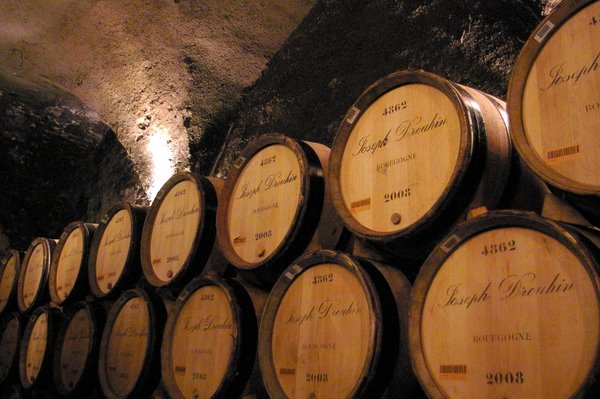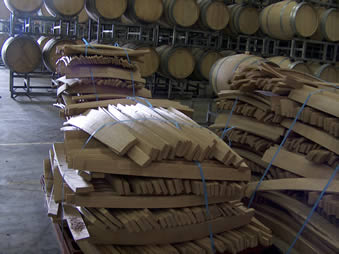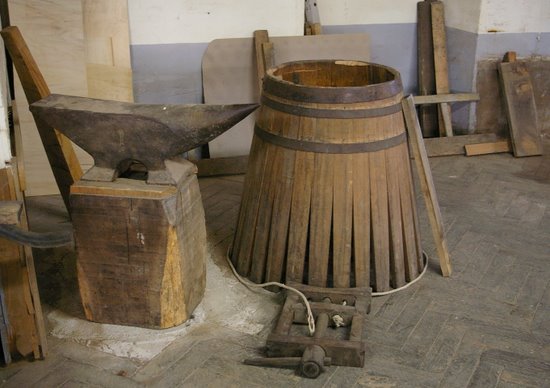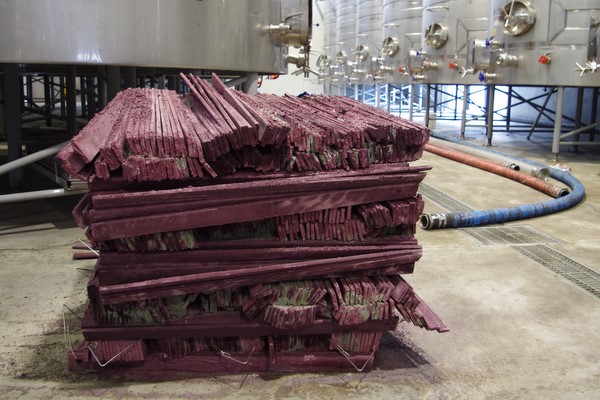|
Learn
about wine:
Oak

One
of the things I love about wine is its link with tradition. While
technology such as refrigeration and stainless steel tanks have made
inroads into modern wineries, the basic winemaking approach is
pretty much the same now as it used to be 50 or 500 years ago, if
that's how you want it to be. I really like that. If you had the
desire, you could build a winery using medieval techniques, and make
brilliant wine in it.
One
of the links with tradition that even the most modern of wineries
maintain is the use of oak barrels. A couple of millennia ago large
clay amphorae were the storage medium of choice for liquids such as
wine. But these are heavy and breakable, and so when oak barrels
came on the scene, they proved extremely popular.
And,
by happy coincidence, wood suited wine very well. Oak, the wood most
commonly used for barrels, is not totally inert. It has an
interaction with wine that skilled winemakers have used to their
advantage.
The
first thing is that oak barrels leach some flavours from the wood
into the wine. The second is that they donít exclude air
completely, but allow the wine to be exposed to a constant but very
low level of oxygen. Both of these can be a good thing; they can be
bad. It depends. It is for this reason that the nature and quality
of oak matters a good deal in barrel construction.
 The
two main types of oak used for wine are French and American. French
oak is finer grained and more expensive; American oak is cheaper and
gives the wine more flavour, but this flavour tends to work better
with richer, more robust wines. The flavour compounds from oak
include those that give a vanilla/coconut character, of which there
are more in American oak, and also those which give toasty, spicy,
woody notes. Sometimes wood can give slightly bitter green notes,
and these aren't desirable. I also get a bit of tar-like character
from some oaked wines. The
two main types of oak used for wine are French and American. French
oak is finer grained and more expensive; American oak is cheaper and
gives the wine more flavour, but this flavour tends to work better
with richer, more robust wines. The flavour compounds from oak
include those that give a vanilla/coconut character, of which there
are more in American oak, and also those which give toasty, spicy,
woody notes. Sometimes wood can give slightly bitter green notes,
and these aren't desirable. I also get a bit of tar-like character
from some oaked wines.
For
use in barrel construction, oak is cut into small pieces called
staves, which are then used to make the barrel. These are seasoned
for a period: three years outdoors is the ideal, in a climate where
there is some rain. If the seasoning is suboptimal, undesirable
flavours can remain in the oak ready to be transmitted to the wine.
During
barrel construction these staves are joined together with metal
hoops, and then heated over a fire to soften the wood and make it
pliable. This heating process can char the inside of the barrel, and
the degree of charring or toasting is important in how the barrel
will interact with the wine. Itís another variable.
New
barrels impart more flavor to wine than old. Barrels are re-used for
several years, and the amount of new or old oak used in a wine is
important. The use of too much new oak, which makes the wine taste
oaky, is widely considered to be a wine fault. And some wines are
better able to cope with oak than others.

Most
serious red wines are aged in barrel. But barrels are expensive, and
so alternatives have been tried. One is to bolt oak staves into a
stainless steel tank. Another is to use oak chips, toasted according
to the winemakers desire and then added to a barrel of wine. These
oak alternatives don'rt give as good results as using barrels, but
this may partly be because the oak used is of lesser quality and
isn't seasoned as well. What this means is that even modern wineries
will usually have some barrels Ė perhaps their only link with the
past.

Oak staves that have been in a tank of red wine
You'll
gather from all this that oak is a complicated subject. For a
winemaker, barrels are a critical tool, and choosing the right ones
and using them in the right ways is one of the main ways that
winemakers can alter the flavour of wine.
See
also: how barrels are made
Back
to top
|

